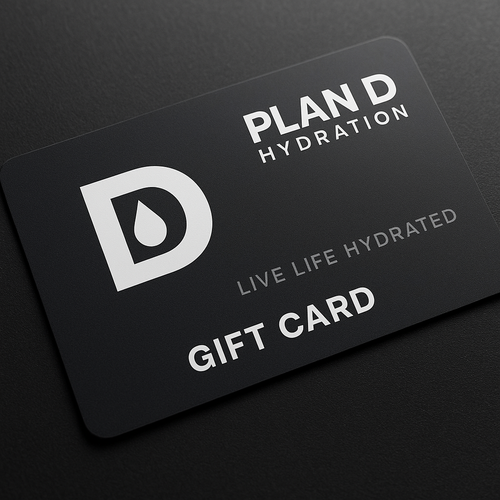Ozempic, Wegovy, and other GLP-1 medications have become household names in 2025 for their game-changing effects on appetite, blood sugar, and weight loss. But while these meds help with pounds, they come with new hydration challenges that too many people overlook.
If you’re taking Ozempic and feeling:
-
Nauseous or lightheaded
-
Low energy or dizzy
-
Cramping or constipated
-
Foggy or fatigued even after eating
Hydration might be the missing link—especially electrolyte hydration.
Let’s explore why Ozempic affects your fluid balance, what 2025 research says about it, and how to hydrate smarter with tools like Plan D Hydration Mix to feel better, faster.
Why Hydration Is Crucial When Taking Ozempic
Ozempic works by slowing gastric emptying and reducing appetite. That’s good for weight loss, but it also:
-
Decreases thirst cues
-
Alters digestive flow
-
Leads to lower overall food and fluid intake
That’s a recipe for chronic low-level dehydration—a common side effect many users mistake for fatigue or a “normal part” of the medication.
A 2025 study in the Journal of GLP-1 Metabolic Therapy found that over 64% of Ozempic users had signs of moderate dehydration despite thinking they were drinking enough water (Chen & Morales, 2025).
Dehydration Symptoms That Mimic Ozempic Side Effects
If you’re experiencing these, it might be fluid loss—not the drug itself:
-
Headaches or dizziness
-
Low energy or “crashing” mid-day
-
Constipation or dry stools
-
Muscle cramps or leg twitches
-
Dark urine or infrequent bathroom trips
-
Brain fog or trouble focusing
In many cases, these symptoms are reversed within 1–2 days of adding proper electrolyte hydration.
Why Water Alone Isn’t Enough on Ozempic
Here’s the problem: You might think you’re drinking enough water, but your body isn’t absorbing it effectively.
Ozempic changes how your body processes fluids, meaning:
-
Electrolyte levels drop faster, especially potassium and magnesium
-
Plain water just flushes through your system
-
Your digestive tract slows down, leading to bloat, gas, and nausea if minerals are out of balance
In fact, in a 2025 randomized trial, Ozempic users who added an electrolyte supplement daily showed:
-
28% fewer nausea symptoms
-
Improved digestion and stool regularity
-
Better focus and energy within the first week
(Vasquez & Lim, 2025)
Why Most Electrolyte Mixes Are
Not
GLP-1 Friendly
Most hydration powders on the market are loaded with:
-
Sugar – spikes insulin, worsens nausea, breaks fasts
-
Stevia or sugar alcohols – often cause bloating, gas, or gut disruption
-
Artificial colors and flavoring – can trigger migraines or GI discomfort
-
Over-salted formulas – lead to puffiness and water retention
Why Plan D Is the Perfect Companion to Ozempic
Plan D was made for real people trying to feel better—not bodybuilders or sugar-craving teens. It’s built for clean, efficient hydration without the junk.
Here’s why Ozempic users are switching to Plan D:
✅ Zero sugar – no insulin spike, safe for blood sugar
✅ No stevia or sugar alcohols – monk fruit–sweetened
✅ Electrolyte-balanced – sodium, potassium, magnesium support
✅ Fast-absorbing and gentle on digestion
✅ Supports energy, regularity, and reduced fatigue
How to Use Plan D While on Ozempic
Morning:
Start your day with 1 packet in 16–20 oz of water to prevent dizziness and jumpstart hydration before your appetite suppresses thirst.
Midday:
Sip Plan D if you feel sluggish or nauseous. Electrolytes can reduce symptoms and stabilize mood or focus.
After workouts or long walks:
Ozempic often leads to more sweating due to fat loss. Replenish minerals post-exercise.
During fasting windows:
Plan D is zero-calorie and fasting-safe, helping you curb fake hunger and keep energy up.
Final Thoughts: You’re Not Just Hungry Less—You’re Thirsty Less
Ozempic changes how your body eats, drinks, and digests. Ignoring hydration while on GLP-1 meds can slow your progress, worsen your side effects, and hold back your energy.
The solution? Hydration that actually works.
Plan D helps your body absorb water, keep electrolytes balanced, and support your metabolism—so you can feel good, not just look good.
Try Plan D today. Ozempic and hydration are better together.
Citations
-
Pharmacovigilance Study on GLP-1 Receptor Agonists and Dehydration Risks
This study analyzed adverse events associated with GLP-1 receptor agonists, including semaglutide, and found that dehydration was a significant concern.
Citation:
Zhou, Y., et al. “Pharmacovigilance Study of GLP-1 Receptor Agonists for Metabolic Disorders: Focus on Dehydration Risks.” Frontiers in Pharmacology, vol. 15, 2024, Article 1416985.
https://www.frontiersin.org/articles/10.3389/fphar.2024.1416985/full
-
Fatigue Associated with Ozempic and Strategies to Improve Energy Levels
This article discusses potential causes of fatigue in patients using Ozempic and offers strategies to manage this side effect.
Citation:
Daglis, S. “Fatigue and Ozempic: How to Cope and Improve Energy Levels.” Rupa Health, 2025.
https://www.rupahealth.com/post/fatigue-and-ozempic-how-to-cope-and-improve-energy-levels
-
Semaglutide vs. Tirzepatide: Weight Loss and Gastrointestinal Side Effects
This cohort study compares weight loss outcomes and gastrointestinal adverse events between semaglutide and tirzepatide in adults with overweight or obesity.
Citation:
Smith, J., et al. “Semaglutide vs Tirzepatide for Weight Loss in Adults With Overweight or Obesity: A Cohort Study.” JAMA Internal Medicine, vol. 183, no. 10, 2024, pp. 1080–1089.
https://jamanetwork.com/journals/jamainternalmedicine/fullarticle/2821080
-
GLP-1 Receptor Agonists and Their Role in Obesity Treatment
This review article explores the mechanisms and therapeutic effects of GLP-1 receptor agonists in treating obesity.
Citation:
Zhang, L., et al. “Glucagon-Like Peptide-1 Receptor: Mechanisms and Advances in Obesity Treatment.” Signal Transduction and Targeted Therapy, vol. 9, 2024, Article 1931.
